Are you getting a new puppy? Congratulations! Now that you have made this big decision, it’s time to think about what you need for them.
Puppies require a lot of supplies, but it can be hard to know what is needed and what is not. And going to the pet store without any idea of what you need can be overwhelming.
Many of these items will be difficult to purchase until you’ve picked out your puppy. Or at least decided on a breed. But you will want to purchase most of it prior to bringing the puppy home.
It’s easier to shop for puppy supplies without your new puppy than with them. For Luna, we had everything we needed, because we already had Morgan, except for her crate. Since we met the person in the pet store parking lot, we took her with us to pick out a crate before going home.
That proved to be a bad decision. It was so much more difficult than it needed to be.
She was scared and didn’t know how to walk on a leash nicely yet. Then the pet store was short-staffed and we couldn’t find anyone to help us.
We ended up just getting a small crate that would work for a month or so. We just wanted to get her out of the store and home.
Learn from my mistake, buy as many supplies as you can BEFORE you bring your puppy home.
This post may contain affiliate links. That means if you click on them and buy something, I may receive a small commission at no cost to you. Read my Disclaimer Policy to learn more.
Puppy essentials checklist
The following is a list of essential items you will need for your new puppy.
This list is not breed-specific. But, most puppies have similar needs regardless of the breed.
A dog crate or kennel

A crate is necessary to crate-train your puppy. Crate training is highly recommended as it gives your puppy a safe place to be when unsupervised.
Puppies can quickly get in trouble when not being supervised. They are known to chew anything they can. And puppies have a tendency to potty where ever they are until fully trained.
Having your puppy in a crate when unsupervised will limit both of these issues.
A crate can also become a puppy’s safe space. They can go in there when they need alone time. Luna and Morgan both love their crates and will go in them off and on throughout the day.
There are three types of crates for dogs. These are hard-sided, soft-sided, and wire crates. I only recommend hard-sided or wire crates for most uses.
Hard-sided crates and wire crates are generally safe to keep your puppy in while unsupervised.
I would not leave a puppy in a soft-sided crate. They could easily break their way out of those by chewing and scratching the soft sides.
While no crate is escape-proof, the wire and hard-sided types are more likely to contain your puppy than a soft-sided one.
Here is more information about choosing the right crate for you and your puppy.
Baby gates
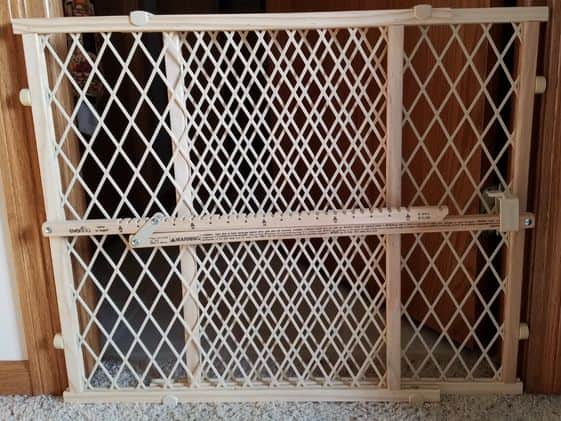
Baby gates are helpful for limiting which rooms your puppy has access to. They can even be used for as long as you have your puppy.
I used to use a baby gate to block off the rooms where the kitty food and litter boxes are. This allowed Allie to get in but not the dogs.
I say “used to” because we had to stop using the gates for Allie. She is now 14 years old and is having pain in her back. This makes jumping a baby gate difficult for her.
Puppy food
When you first bring your puppy home, you should use the same food they are on when you get them.
After your puppy has adjusted to their new home, you can consider switching to different food.
There are so many different dog foods, you will need to do some research before picking one.
Also, discuss it with your vet as they can give you ideas of what to feed your puppy.
Dog training book
A dog training book can help to teach you how to train your puppy to be a well-behaved dog.
I personally like the dog trainer Zak George. He has a couple of books and many Youtube videos on dog training.
For more information on Zak George and his dog training read my review here.
Collar and leash
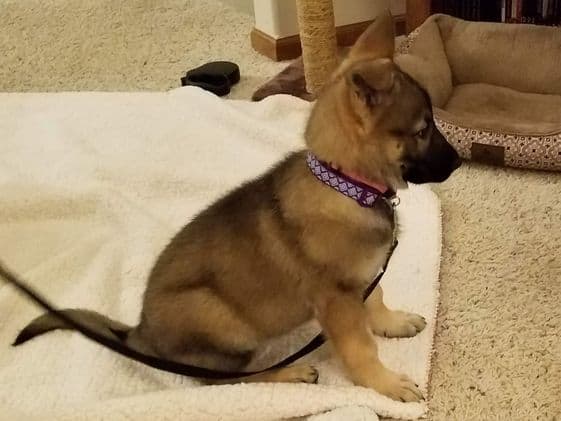
A collar and leash are both necessary to allow you to take your dog outside. I recommend using a 6-foot leash as it gives your puppy some room while still being able to maintain control of them.
It is much safer to have your puppy on a leash when outside. Otherwise, they may run off and may not come back.
Also, many towns and cities have leash laws that require you to have your dog on a leash.
Harness
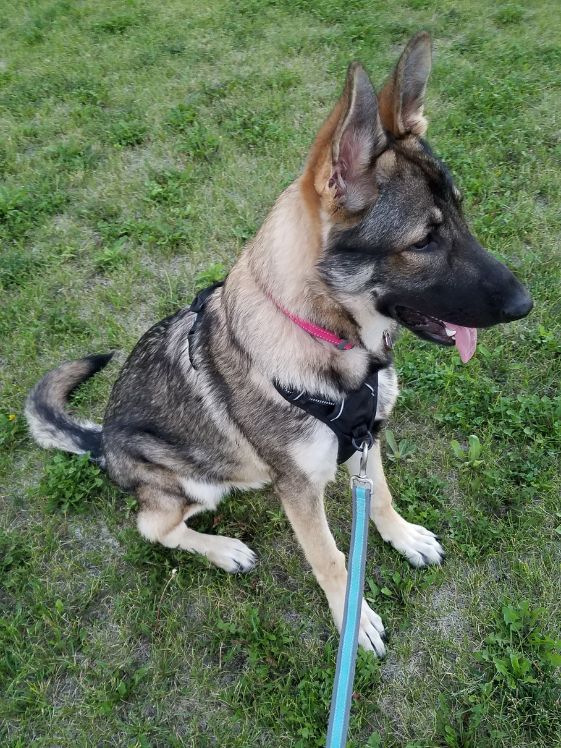
Having your puppy wear a harness when going for a walk is safer than using just their collar.
Many puppies start leash walking by pulling on the leash. This could lead to them hurting their trachea if you walk them with a collar.
Walking your puppy with a harness instead eliminates any pressure on their trachea, making injury unlikely.
Luna wears a Freedom harness, read the review here. And Morgan wears the Petsafe harness.
ID tags
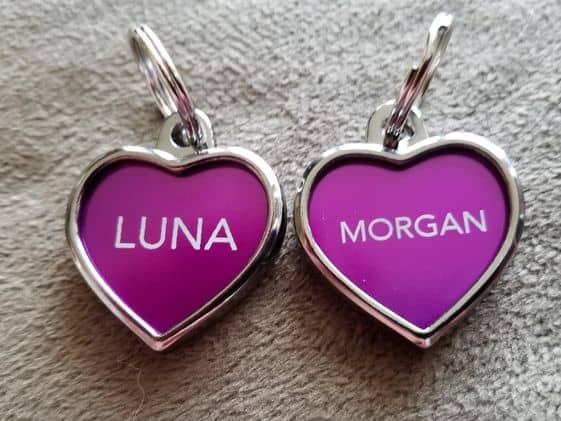
Identification tags are a must-have item in case your puppy ever gets loose outside.
There are many options for a customized id tag for your puppy. You can get them on Amazon, Chewy, or check with your local pet store.
The ones I purchased at the pet store allowed me to engrave Luna and Morgan’s names on one side and my name and phone number on the other side.
Dog bowls
There is a large variety of food and water bowls. They come in plastic, stainless steel, and ceramic.
I have not used ceramic bowls for my dogs, but I have used both plastic and stainless steel.
My favorite bowls for water are the “spill-proof” stainless steel bowls. They are significantly less likely to spill than a plastic bowl.
Luna did figure out how to spill these, but thankfully not as often as the plastic bowls. And once she got past puppyhood, she stopped spilling it altogether.
You can use the same type of dish for food and water. Or you can get different types for them.
Luna is a speed eater, so we got her a slow feeder bowl. Here are some more tips to slow your puppy’s eating down if you have a speed eater like Luna.
Morgan currently uses a stainless steel bowl with a non-skid ring on the base. However, she may be getting a slow feeder bowl soon too. Her new weight loss diet has made her a speed eater too.
Training Treats
New puppies need a lot of training to grow into a well-behaved adult dogs. And training is easier with treats.
I recommend using small, easy-to-break treats for your puppy. This allows you to treat your puppy often without giving them too many treats each day.
I started with using the Natural Balance dog treats for Luna and Morgan when they were puppies. Now I use those plus a variety of others.
Poop bags
Poop bags are a necessity if you plan on taking your puppy for a walk.
If your puppy poops when you are walking you need to pick it up. Having poop bags gives you a way to pick it up and dispose of it.
There are two options for poop bags. You can either buy them or use grocery bags that you have laying around your house.
I prefer to buy poop bags as many come in a roll. This roll can be put in a dog poop bag dispenser that can be clipped to the leash.
This makes it easier to remember to bring the bags with you on a walk. You only have to remember to refill the dispenser when you use the last bag.
Toys
Puppies need toys to keep them occupied and to help with their teething.
I recommend getting a variety of toys for your puppy. This will help you figure out what they like.
Some dogs, like Morgan, only like chew toys. Others, like Luna, are less picky.
Plush toys

Plush toys are stuffed animals for dogs. Some are made out of more durable fabric to withstand puppy chewing. At least withstand it longer than a regular stuffed animal.
Many plush toys have squeakers in them. Some also crinkle.
Plush toys are some of Luna’s favorites, especially if they squeak.
Puppies, and really any age dog, should be supervised when playing with a plush toy. Over time the toy will begin to tear. This could lead to a potential issue if your puppy swallows pieces of it.
Fetch toys

Fetch toys can be anything from a ball to a Kong flyer to a plush toy. As long as your puppy will chase it, it can be a fetch toy.
For outside, Luna will only play fetch with a Kong flyer. She will chase anything we throw, but she will only bring the Kong flyer back.
Inside, Luna will play fetch with almost any toy of hers. Pick a few types and see what your puppy likes.
Tug toys

Tug toys are just like they sound. Toys that you and your puppy can play tug with.
Playing tug is a great way to bond with your new puppy. It also helps to burn off some of that puppy energy.
Make sure the tug toy is long enough that your puppy cannot easily reach your hand while holding the other end.
Tug toys come in a variety of types, such as rope toys, plastic or rubber toys, and homemade toys.
Just make sure to put the tug toy away when you aren’t supervising your puppy. Especially if you have a rope toy.
Luna liked to pull the fibers loose from the rope toys she had as a puppy. This could lead to potential issues if she were to swallow those strings.
Instead of using a rope toy, you can make a DIY t-shirt toy that looks similar to the rope toys. The advantage is it’s made out of t-shirts, so no tiny strings for a dog to pull loose.
Puzzle toys
Puzzle toys provide mental stimulation for your puppy. The most well-known puzzle toy for dogs is the Kong toy.
Kongs are designed to be filled with food and treats and then given to your dog.
Your dog then has to work to get the food out of the kong. To make it more difficult you can “seal” the end with peanut butter and then freeze it.
Frozen Kongs usually take a dog longer to get the food out. These are great to give to your puppy when you need to get some stuff done. It should keep them occupied and out of trouble.
Snuffle mats are another type of puzzle toy. It has strips of fabric that come out the top of the mat.
You place dog food or treats among the strips of fabric. Then your puppy has to sniff around trying to find all the treats in the mat.
These are also great for challenging your puppy’s mind. The only downside is you do need to supervise your puppy while they use it. Otherwise, your puppy may try to eat the fabric from the mat.
Here are directions for making your own snuffle mat.
Chew toys

Chew toys are for, you guessed it, chewing.
Chewing is a natural behavior for dogs. And puppies chew a lot to help with the teething process. Chew toys can help relieve some of that discomfort. And by providing appropriate things to chew you can hopefully limit inappropriate chewing.
Chew toys come in all shapes and sizes. From Nylabones to bully sticks and more.
Dog brush
A dog brush is essential for keeping your puppy’s coat healthy and free of knots.
How often you brush your puppy will depend on their coat type. Dogs with shorter coats may only need to be brushed once a week. Whereas dogs with longer coats may need to be brushed daily.
Start slowly when brushing your puppy. Let them get used to the sensation of being brushed. And give them plenty of breaks.
You may want to start with a soft bristle brush and then upgrade to a firmer brush as your puppy gets used to being brushed.
For Luna, I use a regular brush, a rake, and the Furminator. Some people love the Furminator and some hate it. It definitely gets the fur out of her and as she sheds constantly, I will use whatever works.
Puppy shampoo
Puppies don’t need to be washed with shampoo very often. They do need to be introduced to baths regularly, but mostly without shampoo.
Here is more information on how often to bathe your puppy.
For the times you do need to shampoo your puppy, get one that is made for puppies.
Puppy skin is different than adult dog skin. It’s more sensitive and can be easily irritated.
Shampoos made for puppies are designed to be gentle on their skin.
Flea and tick preventatives
Flea and tick preventatives are important for all dogs. They help prevent your puppy from getting fleas or ticks.
There are a variety of flea and tick preventatives on the market. Some are made specifically for puppies and some can be used for all dogs.
Speak with your veterinarian to see what they recommend for your puppy. You can then either purchase these from the vet or at the store. I usually buy mine on Chewy.
Heartworm medication
Heartworm medication is another preventative that all dogs need.
A heartworm is a parasitic worm that can live in your dog’s heart. It’s transmitted by mosquitoes and can be fatal if left untreated.
There are a variety of heartworm medications on the market. But, all heartworm medication is only available with a prescription from a vet.
This is because they need to do a blood test to verify that your puppy does not already have heartworms.
Once the blood test is complete, your vet will prescribe the type of heartworm medication they carry. If your puppy won’t eat the one the vet offers, request a different one.
Luna absolutely refuses to eat the one my vet carries at the clinic. Instead, they have us order the one she will eat through their online shop.
Enzyme cleaner
It’s going to happen. At some point or another, your puppy will have an accident in the house. When that happens, you want an enzyme cleaner on hand.
Enzyme cleaners are stain and odor removers specifically designed for pet stains. They make it much easier to get the smell out of the carpet. And getting rid of this
Getting an enzyme cleaner designed to get rid of the smell of urine before it’s needed will make cleanup faster.
Paper Towels
You will go through a lot of paper towels when you first get your puppy. They will be used for cleaning up messes, drying off wet puppies, and more.
Invest in a big pack (or two) of paper towels to help make cleanup easier.
Vet care
Finding a vet you trust is probably the most important decision you will make in regard to puppy care.
Get recommendations from local family, friends, neighbors, and coworkers that have pets. Ask which vet they use and if they are happy with them.
Also, consider how close the vet is to where you live and work. You want one you trust, but you also want one that is convenient.
Nice to have puppy supplies
The items on this list are not essential, but they are nice to have. They will make your life with a puppy easier in some way.
Here is a list of nice to have supplies for your new puppy:
Bark Box/Super Chewer
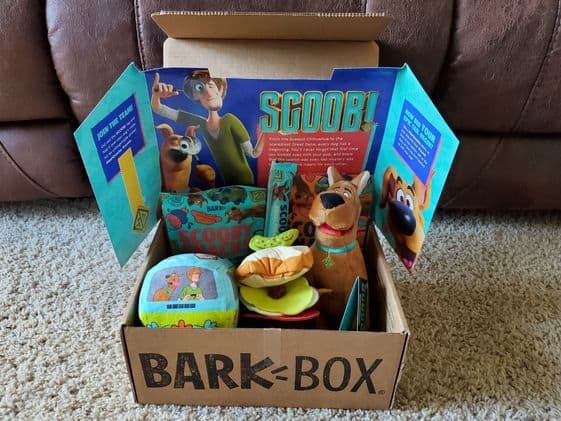
Bark Box is a monthly subscription service that sends you a box of themed toys and treats for your dog to enjoy. The themes change every month, so you may never see what is in the picture above.
Super Chewer is Bark Box’s answer to those dogs that destroy their toys. These toys are much more durable than the toys that come in the boxes from Bark Box.
Puppy Training Planner
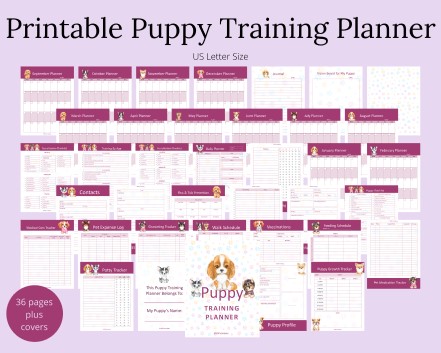

A puppy training planner allows you to keep all of your puppy’s information in one place. This one has pages for your puppy’s information, along with a potty tracker, growth tracker, and vaccination tracker.
It also has a puppy checklist, socialization checklist, and weekly training tracker where you can keep track of what you have taught your puppy and whether you have practiced it during the week. This puppy training planner comes in multiple colors. You can see all the colors in my Etsy shop.
Potty Bells
Potty bells can help with potty training by giving your puppy a way to tell you they need to go out.
It is best to use the same door every time your puppy goes out to go potty when you first start using the bells.
That way, you can ring the bells every time your puppy goes out to potty. Your puppy should eventually catch on that the bells mean potty time.
Once they realize that, they should start to use them when they want to go out.
Clicker trainer
A clicker trainer is a great way to train your puppy. It is a small handheld device that makes a clicking noise when you press the button.
You can use it to mark desired behaviors. For example, if you click when your puppy sits, they will eventually learn that sitting gets them a click (and usually a treat).
This is a great way to train your puppy without having to use treats all the time.
Dog bed

There are many types of dog beds ranging from homemade dog beds to store-bought dog beds. And the store-bought ones range from inexpensive to very expensive. You can get them on both Amazon and Chewy.
I recommend getting an inexpensive bed or making one for your puppy’s first bed.
Not all puppies like to use a dog bed. And others will destroy it by chewing it up or peeing in it.
If you start with an inexpensive bed, at least you didn’t spend much if you find out your puppy doesn’t like it.
We have two beds, a little one for Morgan and a larger one for Luna, and Morgan is the only one that sleeps in either bed.
Luna prefers her plastic crate bottom, the carpet, the couch, or the vinyl kitchen floor. Basically anything other than her dog bed.
Treat pouch
A treat pouch makes carrying treats on walks much easier. And until your puppy is walking nicely, having treats on a walk is important.
You could just have a handful of treats or put them in your pocket, but that isn’t always feasible.
For me, I don’t want dog treats in my pockets, so that option is out. And if you have a big, strong puppy or dog, like Luna, having treats in your hands is a bad idea.
I need both hands available to hold Luna’s leash if another dog or something exciting comes by. I can’t hold the leash with both hands if I have a handful of treats.
A treat pouch solves that problem. It’s a place for the treats that aren’t in my pocket and allows me to use both hands.
No Chew Spray
No chew spray is a bitter-tasting spray that you can use on things you don’t want your puppy to chew.
It is important to start using it early before your puppy starts chewing on something.
If you wait until they are already chewing on something, they may not make the connection between the taste and the item they are chewing.
Nail Trimmer
Trimming your puppy’s nails is important for their health and also for your sanity.
If you don’t trim their nails, they can get too long and start to curl under. This can be painful for your puppy and also cause them to change the way they walk.
Trimming their nails also helps to keep your furniture and floors looking nice.
There are two main types of nail trimmers, nail clippers and nail grinders.
Either type is fine to use, just read the directions and go slowly.
Dog Toothbrush & Paste
Cleaning your puppy’s teeth is important for their dental health. It is best to start when they are young so that they get used to it.
Do not use the same toothpaste you use for yourself. There is toothpaste made specifically for dogs.
There are also different types of brushes for dogs. One type is a brush that goes on your finger. You then clean the teeth with your finger brush.
The other type is more like a toothbrush for humans but is shaped to more easily get your dog’s teeth. Amazon and Chewy both have several options to choose from.
Bright Box Subscription

If brushing your puppy’s teeth frequently is something you’d rather avoid, you should get a Bark Bright Dental Kit subscription.
The Bark Bright Dental Kit is from the same company that makes Bark Box and it comes with dental chews and dog toothpaste.
The special dog toothpaste is applied directly to the chew and helps to clean your dog’s teeth.
It still doesn’t replace brushing your dog’s teeth completely, but it will help those who want to limit actually brushing their dog’s teeth.
Longline Leash
A longline leash is a longer leash, usually 20 to 30 feet, that allows your dog to have more freedom while still being on a leash.
This is great for when you are first starting to train your puppy outside. It gives them enough space to make their own decision to listen to you.
A longline leash is especially good for recall training (teaching your dog to come when called).
Food Container
A food container is important if you feed your puppy dry food.
You will need a place to store the food so that it doesn’t get wet or attract bugs.
A covered food container is best. You can also use a tupperware-type container or even a Ziploc bag.
Just make sure the food is in a container that keeps it fresh and dry.
Pooper Scooper
A pooper scooper is important for picking up your puppy’s poop in your yard.
You can use a plastic bag, but a pooper scooper makes it much easier. Especially if you are cleaning up multiple days worth of poop at one time.
Door Buddy

The door buddy is an item I found after I realized Allie was struggling to jump the gate to get to her litterbox and food.
It’s a strap that attaches to the door and door frame to prevent the door from opening too far. It also has a foam piece that goes on the door to prevent it from closing.
This allows Allie to squeeze through the opening while preventing Luna and Morgan from going into the room.
The one caution it has is that it may not work for large dogs. Since it is only stuck on the door and frame, a good push could pull it off.
So far it has worked against my dogs, but Luna stops when she feels a little resistance. If your dog is more energetic or determined, it may not work for you.
It also only works for those who have a dog that is larger than the cat. Otherwise, the dog will be able to go through the same opening the cat uses.
Car Safety Harness
A car safety harness is important if you are going to be taking your puppy in the car.
It is a harness that attaches to your dog and then to the seatbelt. This prevents your dog from being thrown around in the car in case of an accident.
It is also good for keeping them from jumping out of the car when you open the door.
Might want puppy supplies
These are items that you might want for your puppy.
Tie out stake
If you don’t have a fenced-in yard, but you want to place your puppy outside without having to hold on to the leash, a tie-out may be useful.
If you do decide to use a tie-out, I recommend not leaving your puppy outside without supervision for very long.
It is possible for your dog to get tangled up in their tie-out. To prevent injury, check on your dog frequently or be outside with them.
Puppy Playpen
A puppy playpen can be useful if you want to confine your puppy but want to give them more room than their crate.
This is helpful when your puppy is in the destructive chewing phase.
It allows you to let them have some space to run around while knowing they can’t get into anything you don’t want them to.
Puppy potty pads
Potty pads give your puppy a place to pee inside the house.
Some people use these hoping they make potty training easier. Others use them because they have a small dog in an apartment.
I personally have never used puppy pads. I feel that allowing a puppy to pee and poop inside for a while and then not allowing it can be confusing.
If you decide to use puppy pads, do your research to find the best ones.
Dog Trainer
While not a physical item, I think it is important to mention the importance of finding a good dog trainer.
A dog trainer can help you with things like potty training, recall training (getting your dog to come when called), and obedience training.
They can also help with behavior problems such as barking and jumping.
Pet Sitter/Walker
If you are going to be away from home for more than a few hours, you may want to consider hiring a pet sitter or dog walker.
This is someone who will come to your house and take care of your dog while you are gone.
They will make sure your dog has food and water, goes potty, and gets some exercise.
Boarding Facility
If you are going to be away from home for an extended period of time, you may want to consider boarding your dog.
This is where you drop off your dog at a facility and they take care of them while you are gone.
They will provide food, water, and exercise. Some boarding facilities also offer grooming and training services.
Pet Insurance
Pet insurance is something you may want to consider.
It can help pay for unexpected veterinary bills.
I have never had pet insurance, so I can’t say what they cover or whether it is worth it or not. I
I can say, that vet bills can add up quickly. Especially if your puppy gets sick or injured.
Dog Camera
A dog camera is a fun way to check in on your puppy while you are away.
There are many different types and brands of dog cameras. Some even allow you to give your dog a treat!
Paw Print Crafts

Paw print crafts make a great keepsake for your new puppy.
There are Mother’s Day and Father’s Day paw print crafts, along with other holidays like Halloween.
There is also a birthday paw print craft that would make a great keepsake for your puppy’s first birthday.
To see all the options, check out this Etsy shop.
Puppy Adoption Certificate

Make the day you bring your puppy home even more special by getting them an adoption certificate.
Just fill out your new puppy’s name, your name, and the date you bring them home to have a special keepsake of this special day.
Bonus: After you bring puppy home
There are a couple of things you should get for your new puppy that need to be done after they have come home with you.
Pet license
Depending on where you live, you are required by city ordinance to license your puppy.
Around here I can get that license from certain vet clinics, online through my city website, or at the police department.
Different cities may have different locations to purchase a license.
Microchip
A microchip is a tiny chip that is inserted under your dog’s skin.
This chip contains your contact information.
If your dog ever gets lost, the shelter, pound, or vet can scan them for a microchip and get in touch with you.
The advantage to a microchip is that it is always with your dog. They may lose their collar, but they won’t lose their microchip.
All of my pets have been microchipped and I highly recommend you get your new puppy microchipped as well.
If you got your puppy at a shelter, they may have already done the microchipping. If they did, they will have had you fill out the contact form.
Depending on where you live you can get your puppy microchipped at the vet or through a shelter-sponsored microchipping clinic.
Final thoughts
I hope this list of puppy supplies helps you get everything you need for bringing your new puppy home.
Some of these items can be used for your puppy’s whole life (like the crate if you sized it correctly). And others will need to be replaced or changed as your puppy gets older.
I hope your new puppy adjusts quickly to your home and that this is the start of a long life together.
Related Posts
How To Survive The First 48 Hours With A New Puppy
How To Choose The Right Crate For Your Dog
How To Potty Train Your New Puppy
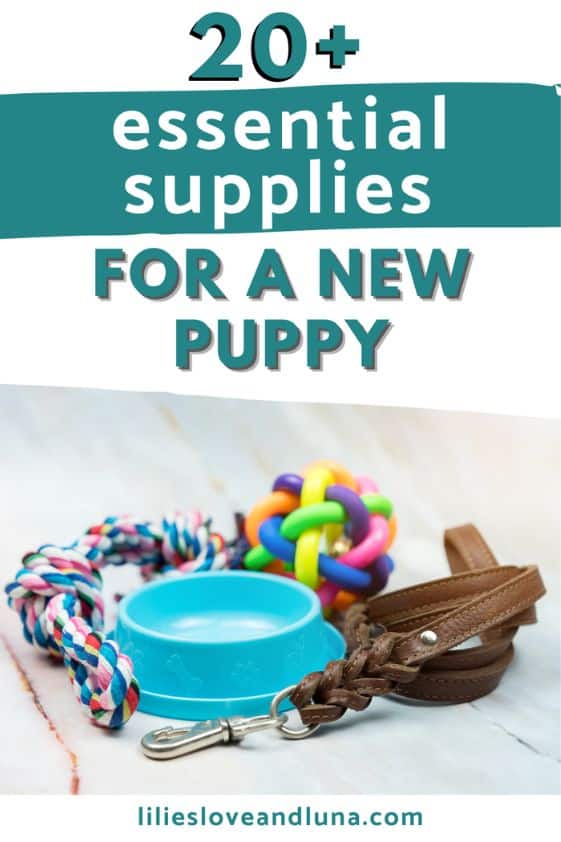



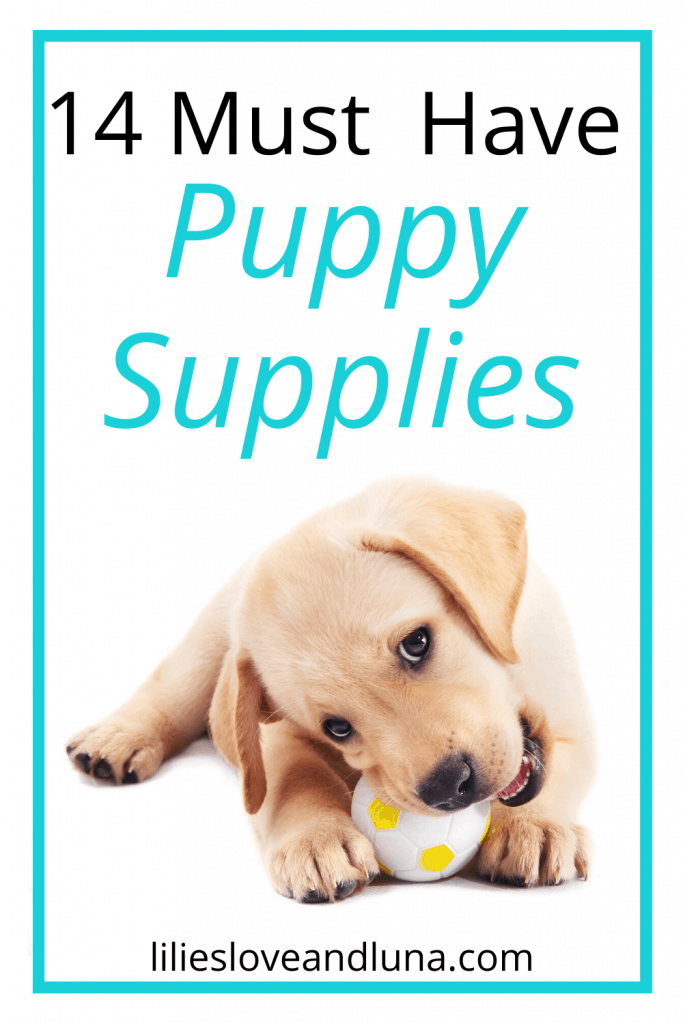
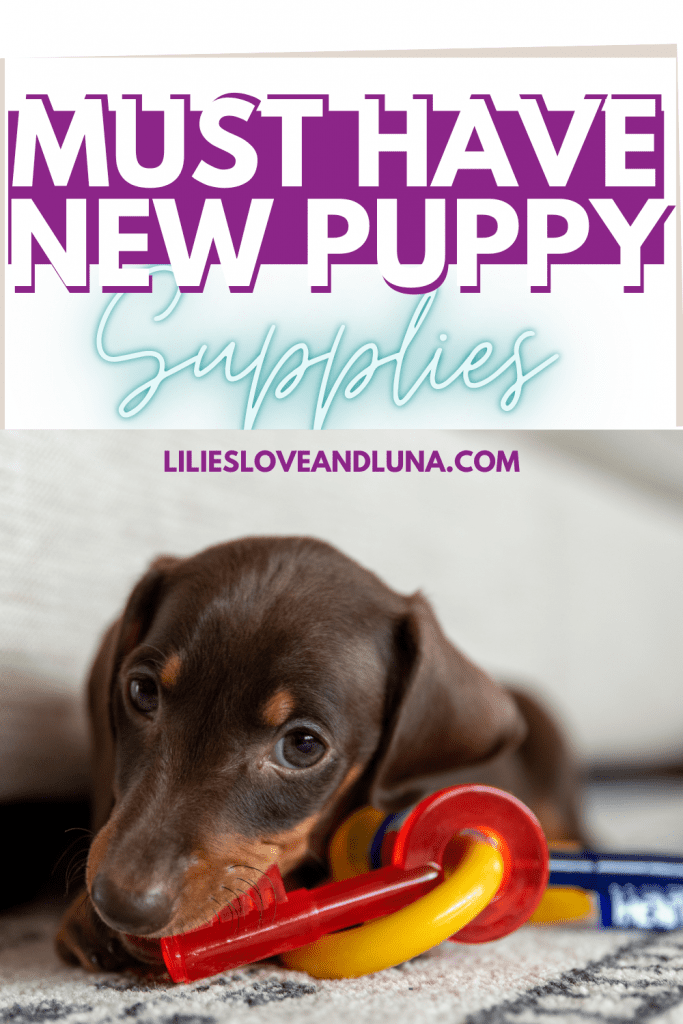


Very helpful list for me! Thank you!
I loved your information
Going to make breathe bones